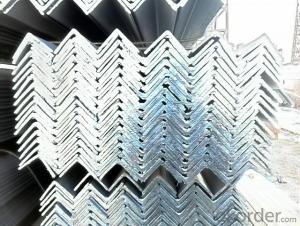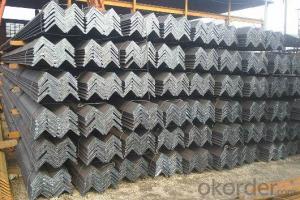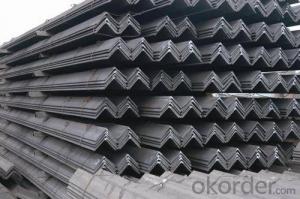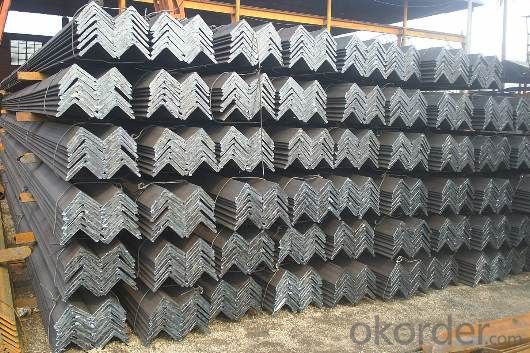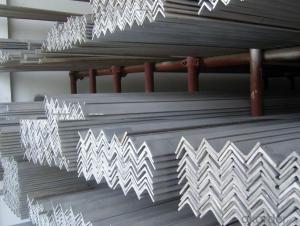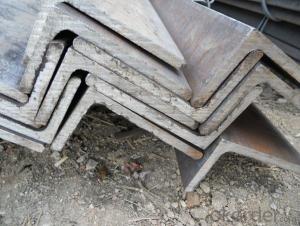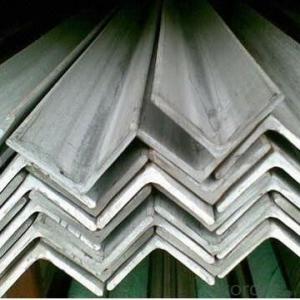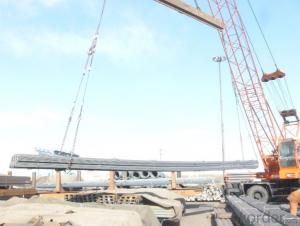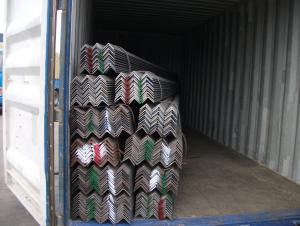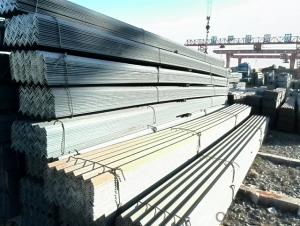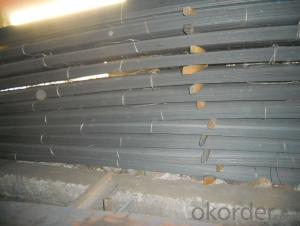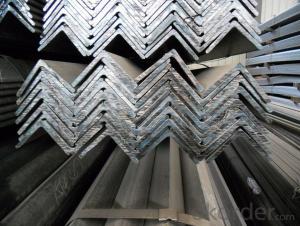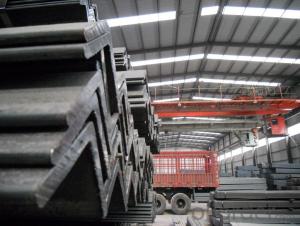Hot Rolled Equal Angles with High Quality
- Loading Port:
- Tianjin
- Payment Terms:
- TT OR LC
- Min Order Qty:
- 25 m.t.
- Supply Capability:
- 20000 m.t./month
OKorder Service Pledge
OKorder Financial Service
You Might Also Like
Product Description:
OKorder is offering Hot Rolled Equal Angles at great prices with worldwide shipping. Our supplier is a world-class manufacturer of steel, with our products utilized the world over. OKorder annually supplies products to European, North American and Asian markets. We provide quotations within 24 hours of receiving an inquiry and guarantee competitive prices.
Product Applications:
Hot Rolled Equal Angles are ideal for structural applications and are widely used in the construction of buildings and bridges, and the manufacturing, petrochemical, and transportation industries.
Product Advantages:
OKorder's Hot Rolled Equal Angles are durable, strong, and resist corrosion.
Main Product Features:
· Premium quality
· Prompt delivery & seaworthy packing (30 days after receiving deposit)
· Corrosion resistance
· Can be recycled and reused
· Mill test certification
· Professional Service
· Competitive pricing
Product Specifications:
Manufacture: Hot rolled
Grade: Q195 – 235
Certificates: ISO, SGS, BV, CIQ
Length: 6m – 12m, as per customer request
Packaging: Export packing, nude packing, bundled
Sizes: 25mm-250mm | ||
a*t | ||
25*2.5-4.0 | 70*6.0-9.0 | 130*9.0-15 |
30*2.5-6.6 | 75*6.0-9.0 | 140*10-14 |
36*3.0-5.0 | 80*5.0-10 | 150*10-20 |
38*2.3-6.0 | 90*7.0-10 | 160*10-16 |
40*3.0-5.0 | 100*6.0-12 | 175*12-15 |
45*4.0-6.0 | 110*8.0-10 | 180*12-18 |
50*4.0-6.0 | 120*6.0-15 | 200*14-25 |
60*4.0-8.0 | 125*8.0-14 | 250*25 |
FAQ:
Q1: Why buy Materials & Equipment from OKorder.com?
A1: All products offered byOKorder.com are carefully selected from China's most reliable manufacturing enterprises. Through its ISO certifications, OKorder.com adheres to the highest standards and a commitment to supply chain safety and customer satisfaction.
Q2: What makes stainless steel stainless?
A2: Stainless steel must contain at least 10.5 % chromium. It is this element that reacts with the oxygen in the air to form a complex chrome-oxide surface layer that is invisible but strong enough to prevent further oxygen from "staining" (rusting) the surface. Higher levels of chromium and the addition of other alloying elements such as nickel and molybdenum enhance this surface layer and improve the corrosion resistance of the stainless material.
Q3: Can stainless steel rust?
A3: Stainless does not "rust" as you think of regular steel rusting with a red oxide on the surface that flakes off. If you see red rust it is probably due to some iron particles that have contaminated the surface of the stainless steel and it is these iron particles that are rusting. Look at the source of the rusting and see if you can remove it from the surface.
Images:
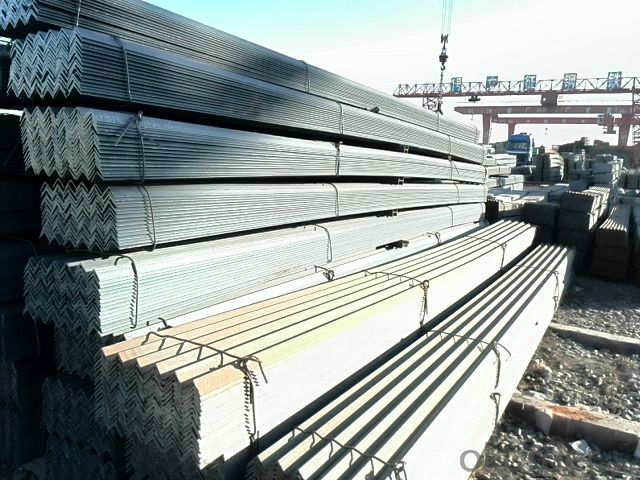
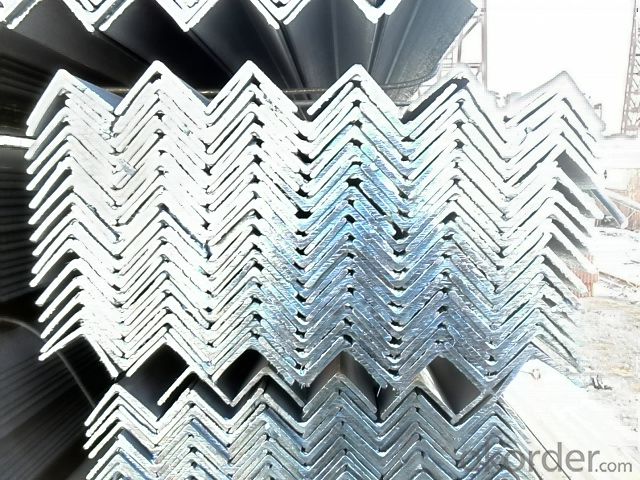

- Q: How do you calculate the strength of a steel angle?
- To calculate the strength of a steel angle, you typically need to consider several factors, including the dimensions of the angle, the material properties of the steel, and the applied loads. The strength can be determined using mathematical equations, such as the yield strength or ultimate strength equations, which take into account the cross-sectional area and moment of inertia of the angle. Additionally, other factors like buckling or lateral torsional buckling may also need to be considered depending on the specific design requirements.
- Q: What are the different methods for cutting steel angles?
- There are several different methods for cutting steel angles, depending on the specific requirements and the tools available. Some of the most common methods include: 1. Manual cutting: This involves using a handheld hacksaw or a metal cutting bandsaw to cut through the steel angle. It is a labor-intensive method and may not be suitable for large-scale projects or precise cuts. 2. Abrasive cutting: This method uses an abrasive wheel or disc to grind through the steel angle. It is commonly done with an angle grinder or a chop saw. Abrasive cutting is faster than manual cutting and can provide reasonably accurate cuts. 3. Plasma cutting: Plasma cutting involves using a high-temperature plasma arc to melt through the steel angle. It is a versatile method that can cut through thick steel angles quickly and accurately. However, it requires specialized equipment and may not be suitable for small-scale or on-site projects. 4. Laser cutting: Laser cutting uses a high-powered laser beam to melt through the steel angle. It is a precise and efficient method that can produce intricate cuts with minimal heat-affected zones. Laser cutting is commonly used in industrial settings and requires specialized equipment. 5. Waterjet cutting: Waterjet cutting utilizes a high-pressure jet of water mixed with abrasive particles to cut through the steel angle. It is a versatile method that can produce precise cuts without generating heat or causing distortion. Waterjet cutting is commonly used in industries where heat-affected zones and material distortion are a concern. 6. Shearing: Shearing involves using a shear machine to apply a cutting force to the steel angle, causing it to fracture along a predetermined line. It is a fast and efficient method for straight cuts and is commonly used for high-volume production. The choice of cutting method depends on various factors such as the size and thickness of the steel angle, the desired accuracy of the cut, the available equipment, and the project requirements. It is important to consider the specific needs and limitations before selecting the most appropriate cutting method.
- Q: How do steel angles perform under dynamic loads?
- Steel angles generally perform well under dynamic loads due to their inherent strength and durability. The structural shape of steel angles, characterized by their L-shaped cross-section, provides excellent resistance to bending and torsional forces. This design allows them to efficiently distribute dynamic loads and resist deformation, making them suitable for various applications in construction, engineering, and manufacturing industries. However, the specific performance of steel angles under dynamic loads can vary depending on factors such as the grade and quality of the steel, the magnitude and frequency of the dynamic load, and the overall design and reinforcement of the structure.
- Q: How are steel angles protected against fire damage?
- Fire-resistant coatings and fireproofing materials are commonly used to protect steel angles from fire damage. These measures aim to prevent or delay the steel from reaching its critical temperature, which can compromise its structural integrity. One popular method of safeguarding steel angles involves applying intumescent coatings. These coatings expand when exposed to high temperatures, creating a protective char layer that insulates the steel and slows down heat transfer. This process effectively hinders the steel from rapidly increasing in temperature, thus enhancing its fire resistance capabilities. Another approach is to utilize fireproofing materials, such as concrete or gypsum-based sprays or boards. These materials act as a barrier between the steel angles and the fire, providing insulation and preventing the heat from reaching the steel. Fireproofing materials are commonly employed in buildings with higher fire resistance requirements, such as tall buildings or industrial facilities. In certain cases, steel angles can be enclosed within fire-rated enclosures for added protection. This entails enclosing the steel angles within fire-rated walls, floors, or ceilings made of materials with exceptional fire resistance properties. These enclosures effectively isolate the steel angles from potential fire sources, adding an extra layer of defense. It is important to acknowledge that the specific fire protection measures for steel angles can vary based on building codes, fire safety regulations, and the intended use of the structure. Consulting with fire protection engineers and adhering to the appropriate guidelines will ensure that the steel angles are adequately shielded against fire damage.
- Q: Can steel angles be used in the construction of religious institutions?
- Yes, steel angles can be used in the construction of religious institutions. Steel angles are versatile and commonly used in construction due to their strength, durability, and ability to withstand heavy loads. They can be used to provide structural support and stability to the building, ensuring its longevity and safety. Whether it is for columns, beams, trusses, or framing, steel angles can be effectively utilized in the construction of religious institutions to meet the specific design and engineering requirements.
- Q: Are steel angles resistant to termites and pests?
- Steel angles do not possess resistance against termites and pests. Due to their metallic composition, termites do not find steel angles appealing as a source of nourishment. Nevertheless, termites can still inflict harm on adjacent materials, like wood or insulation, that might exist within the structure where steel angles are utilized. It is crucial to guarantee that the overall construction is resistant to termites and implement necessary precautions to avert infestations.
- Q: Can steel angles be used for window frames?
- Yes, steel angles can be used for window frames. Steel angles are commonly used in construction due to their strength and durability. They provide excellent structural support and can withstand heavy loads, making them suitable for window frames. Additionally, steel angles can be easily fabricated and customized to fit specific window sizes and shapes. They also offer resistance to corrosion, ensuring longevity and minimal maintenance requirements. Therefore, steel angles are a popular choice for window frames in various applications, including commercial buildings, residential homes, and industrial facilities.
- Q: How are steel angles inspected for quality and compliance with standards?
- Steel angles are inspected for quality and compliance with standards through a series of rigorous tests and inspections. These inspections are carried out by qualified personnel, often trained and certified in non-destructive testing (NDT) methods. The inspection process begins with a visual examination of the steel angles, looking for any surface defects such as cracks, pits, or sharp edges. This examination ensures that the angles are free from any visible defects that may compromise their strength and structural integrity. Next, dimensional checks are performed to verify that the steel angles meet the specified dimensions and tolerances as outlined in the applicable standards. This includes measuring the length, width, thickness, and other critical dimensions to ensure they align with the required specifications. To evaluate the internal soundness of the steel angles, non-destructive testing methods are employed. These methods include ultrasound testing (UT), magnetic particle testing (MT), liquid penetrant testing (PT), and radiographic testing (RT). UT uses high-frequency sound waves to detect any internal flaws or discontinuities, while MT and PT involve the application of magnetic particles or liquid dyes to detect surface cracks or defects. RT, on the other hand, uses X-rays or gamma rays to inspect the internal structure of the steel angles. Mechanical tests are also conducted to assess the mechanical properties of the steel angles. These tests may include tensile testing, which measures the strength and elasticity of the material, and hardness testing, which determines the resistance of the steel to indentation or scratching. These tests ensure that the steel angles possess the required mechanical strength and properties as specified by the standards. Furthermore, chemical analysis is carried out to verify the chemical composition of the steel angles, particularly the levels of various alloying elements. This analysis ensures that the steel meets the required chemical composition standards, which directly influence its strength, corrosion resistance, and other properties. In addition to these inspections, steel angles may also undergo surface treatment testing, such as coating thickness measurement, adhesion testing, or salt spray testing, to ensure that any protective coatings or finishes applied meet the required standards. Overall, the inspection process for steel angles is comprehensive and involves a combination of visual examinations, dimensional checks, non-destructive testing, mechanical tests, chemical analysis, and surface treatment testing. These inspections are crucial to ensure that the steel angles meet the necessary quality and compliance standards, providing confidence in their performance and reliability in various applications.
- Q: Can steel angles be used for agricultural buildings or barns?
- Yes, steel angles can be used for agricultural buildings or barns. Steel angles provide structural support and stability, making them suitable for constructing various components, such as trusses, beams, and frames, in agricultural buildings or barns.
- Q: What is the maximum deflection allowed for steel angles?
- The maximum deflection allowed for steel angles depends on several factors, including the specific grade of steel, the length of the angle, and the applied load. Generally, in structural engineering, deflection limits are set to ensure the safety and performance of the structure. The deflection limit for steel angles is typically defined as a fraction of the span length, such as L/240 or L/360, where L represents the unsupported length of the angle. For example, if the unsupported length of a steel angle is 240 inches, the maximum deflection allowed would be 1 inch (240/240) or 0.67 inches (240/360). However, it is important to note that these deflection limits may vary depending on the specific design codes and standards being used for the project. Consulting the relevant code or seeking guidance from a structural engineer would provide more accurate and specific information regarding the maximum deflection allowed for steel angles in a particular application.
Send your message to us
Hot Rolled Equal Angles with High Quality
- Loading Port:
- Tianjin
- Payment Terms:
- TT OR LC
- Min Order Qty:
- 25 m.t.
- Supply Capability:
- 20000 m.t./month
OKorder Service Pledge
OKorder Financial Service
Similar products
Hot products
Hot Searches
Related keywords
